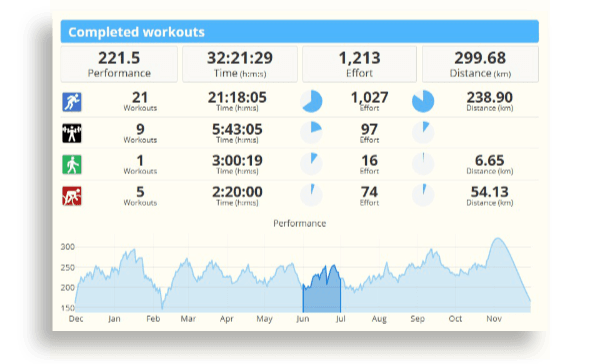Periodization Strategy
How to approach long-term training for maximum impact
Periodized training is the practice of planning multiple seasons of workouts and recoveries in order to achieve peak fitness for a specific race. We explain the basics in an article called Training with Periodization, and in a separate article we cover a similar approach called reverse periodization that better suits people who have a limited amount of time to train during the short and busy days of winter. In this article, we provide insight on how to strategically plan your training blocks for optimal performance — if you choose to adopt this approach to training and racing.
When to begin?
We've been publishing these articles in early January because it's a great time to take a fresh look at the year ahead, however, the most important endurance races typically take place in the spring and fall, so this time of year isn't ideal to start your training. For example, if you want to peak for a spring race, you should already be halfway through your training cycle with months of very specific workouts under your belt.

Runners who choose their A-race as a fall marathon will typically begin their macrocycle in May. The most common starting point for endurance athletes who practice periodization is October. Keep this in mind as you make your plans for 2020 and beyond.
Your best may be 3 to 5 years ahead
Depending on your goals, it can take several years of periodized training to achieve them. For example, if you're middle-of-the-pack runner who wants to qualify and race in the Boston Marathon, it may take a number of years to stack the accomplishments required to move you to the next level of competitiveness.
It's great to dream big, but you need to be realistic about your short-term goals. One of the advantages of carefully crafting a periodized training plan is to avoid overtraining and injury. Reaching too far, too soon will only set you back.
Avoid medium intensity
Whether you embrace traditional linear periodization, reverse periodization, or a hybrid approach, be sure not to fall into the trap of spending too much time in zone 3. Without carefully balancing easy workouts in zone 2 with harder efforts in your upper zones, it will be difficult or impossible to make gains. This is often the downfall of those who choose to only train by feel. Workouts are usually harder than you perceive them to be, so if you're not carefully monitoring your output with heart-rate or power, you can easily be overdoing it and holding yourself back.
A traditional linear plan will have you doing lots of low-intensity miles for the first couple of months building your base fitness. More experienced athletes can jump into reverse periodization plans that have more intensity in the beginning, but smooth out into low-intensity miles later in the program. In both cases the low-intensity workouts play a pivotal role. It is strongly recommended to stick to the tenants of polarized training and plan 80% of your workload in zone 2 with 20% being harder workouts.
Peak performance is unsustainable
When you're performing at your absolute best in your age group and experience level, it isn't something you can sustain for several races, seasons, etc. To truly reach your peak, you must push yourself beyond the norms to a heightened level and put in an effort that will necessitate a long period of recovery. This is one of the tenets of periodization. You build, increase workload, create race-like conditions, taper, then crush your race with everything you've got. That level of exertion is followed by a long recovery, then a gradual rebuilding of your base. Starting over, but starting in a stronger place than you were last time around with a bigger goal ahead.
...if you're not carefully monitoring your output with heart-rate or power, you can easily be overdoing it and holding yourself back.
This is why you can't build for race-day fitness, then continue at that level for a sustained period of time. If you did so, the result will likely be diminishing returns and risk of injury. Instead of achieving new goals, you experience a plateau. Periodized training requires more patience and discipline, but it rewards you with new levels of achievement.
Scheduling a macrocycle
The layout of your year will vary depending on when your A-race takes place, your sport type, the particular training conditions of where you live, etc. A 52-week macrocycle typically provides the opportunity to train and peak for 2 major races with training plans that span 20-weeks. If you want to compete in a longer distance endurance event like an ultramarathon or a full-course triathlon, you will likely need to dedicate more weeks of training (with necessary recoveries).
Let's say you're a runner who has chosen the Berlin Marathon as your A-race. This event takes place in late September. You are starting out in fairly good shape, with a few seasons of active training and racing under your belt, so you will be following a non-linear periodization plan.
Mid-April through mid-May: Your first mesocycle features base training with lots of easy zone-2 running, and some speed work (which is how this non-linear plan deviates from traditional linear periodization). In addition to base fitness you do some hill workouts, strides, and efforts at 5K pace.
Mid-May through mid-June: Now you transition into race focused marathon-pace training with long runs at varying speeds and tempo runs for speed work.
Mid-June to early July: More race-specific milage and workouts at 10K and 5K paces. There are also base fitness zone 2 easy runs. Recoveries are planned and taken seriously throughout the plan.
Early July to mid-August: In addition to other workouts, you do a final 22-mile long run 3 weeks before the A-race. You also compete in a half-marathon tune-up race 4 weeks before the big day in Berlin.
Mid-August to mid-September: You do some long runs at marathon goal pace with short speed intervals to work both slow-twitch and fast-twitch muscle fibers. The final taper before Berlin includes some short intensity workouts to stay sharp.

Should you encounter a setback, such as an illness, injury, or work/family obligation, you will need to adjust your training plan to fit your life. When this happens, it's best to start at the A-race date and work backwards to the present, moving training sessions and tune-up races as needed. This is when the training load and performance charts in SportTracks become invaluable. As planned workouts are added, you will see if your performance will be peaking at the most advantageous time.
These charts are available on the Health page in SportTracks, but you can also monitor your fitness directly in the SportTracks calendar to make sure you're on target as you plan each week.
Experts are real
An optimized annual training plan needs to be made specifically for your goals, and to work with the amount of time that you have to train. That's why getting help from an experienced coach is so valuable. You're probably an expert at something, and you know that other people make mistakes that you wisely avoid in your field. It's the same in endurance sports, so consider contacting a reputable coach for guidance.
Thanks for checking out this article! We hope it provided some useful insight into training strategy.
| Learn more about this topic in our Basics of Periodization and Reverse Periodization articles. |
| Article written by Sam Mallery, Director of Marketing, Zone Five Software Inc. |
